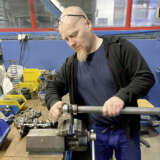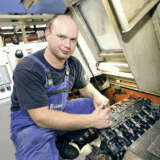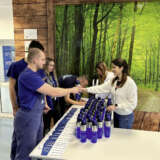The right information at the right time
Particularly in times when the future is hard to predict, it is all the more important to have all the facts readily available at a glance – and to make good use of this information. And that is exactly how our IT director views the role of digitalization: having the right information available at the right place and the right time. In his perfect world, five years from now we will have a Google for the KAMAX world that can supply us with the information we need for a task or automation at any time. We decided to take a look at the digitalization projects that are already underway to get us there.

“Hi there, my name is HANA and I’ll be around more often now. I will guide you through the implementation of our new SAP system “S/4HANA” and answer various questions in the future. Let’s start the journey together!”
First, it is important to create a solid foundation that lets us take data from anywhere, analyze it, and put it to use. SAP S/4 HANA helps us do this. We are in the process of gradually replacing our current SAP system in all of our plants. This will make it possible to depict our processes in standard applications instead of being forced to work with multiple individual solutions and gives us a standard data basis for the entire KAMAX Group. The system is currently being rolled out in Wujin, which is the second plant that is using the new platform. In this way, we are laying the foundation for subsequent digitalization projects – from toolkits to warehousing.
Automated tool production
The ability to entirely automate the production of a set of tools? That is no longer something from the realm of fantasy, but the reality at Tools in Homberg. The KX Bolt Generator records parameters like the size and diameter of a fastener and then outputs a finished tool. And when time is tight, it can do so in a matter of hours – instead of eight weeks later, as had been the case to date. The solution takes care of every single step in the process: it plans the stages, generates a CAD drawing and a digital twin, and compiles the documentation. It even requests the raw materials. The goal is to use the newly acquired expertise of Tools’ software engineers to generate interest in stepping up automation of our bolt production.
Once we have a completed tool, we are able to begin producing the parts. To ensure that we know precisely how many parts the machine has already produced, sensors are used for piece counting in Homberg, Osterode, and Lapeer. Before now, our colleagues at each plant had to manually transport their containers full of fasteners to the scales up to 50 times a day – and depending on the locations of the machines, this sometimes meant walking through the entire production hall. Now, thanks to our digital incubator nexineer, without leaving their machines our colleagues can use an app to view not only the number of bolts that have been completed, but also the container in which they can be found. They can send this data directly to the SAP system.

Our Nexineer digitization team at a workshop
Where is something amiss?
These and other data are used to maintain an overview of production, so that we can take remedial action wherever and whenever necessary. For more than a year now, a dashboard in Homberg has been capturing production data from various IT systems and presenting these graphically in a user interface. This allows our colleagues to gain a mobile live view of production, or to analyze past shifts. The report function also automates the calculation of key figures. It can also be used for machines with the operator cockpit, which is currently running as a nexineer pilot project in Jintan and Wujin. It collects information from three different applications and helps to monitor machine processes. Why has a machine stopped? Are we out of raw materials? Are we missing a tool?
According to Tobias Haungs, VP Global Digitalization & IT: “As we continue digitalizing, we are eventually going to reach a point where we are getting answers to questions that we have not even asked yet. Machines are already reporting on low material levels even before they run out and on incidents that might indicate imminent problems. This lets us react in a timely fashion.”
Digitalization goes far beyond that, and it is helping us to get better throughout the KAMAX world. Be it the use of a HoloLens in Turnov for planning production areas, self-driving forklifts in Jintan, or the implementation of digital workflows in supply chain management with our new SharePoint platform – our colleagues worldwide are active digitally. It is especially important that we share our expertise. By sharing knowledge and coordinating our efforts, we can ensure that we are supporting one another, rather than holding each other back. In a best-case scenario, every department in the company will be familiar with digital capabilities and put these to work as tools for their daily tasks.
Creating the necessary conditions in the background
Utilizing these large volumes of data from all areas calls for a high level of data security. That is why we are working to protect our infrastructure. We will be using the Crowdstrike antivirus program to protect our data and information. This uses artificial intelligence to determine whether system processes are running normally on the PC or if there is any unusual activity that might indicate the presence of a virus.
As Tobias Haungs put it: “At the end of the day, our goal is to create value for our company. Every department must be able to digitalize, but digitalization must also empower our departments to carry out their tasks in the best manner possible. This does not necessarily mean having a huge software program that controls everything. For example, we can use micro-apps that network production such that every employee can, as if from a catalog, put together the precise combination they need to do their work. We’ve already got the technical requirements in place to make this possible.”
Interested in finding out more? That’s good, because we need pioneering spirits and people with the urge to explore at all levels. Creative minds full of ideas, as well as technicians who make the technology work. And people who recognize the benefits. That is how we can make digitalization into a process that never ends.
KXpress










